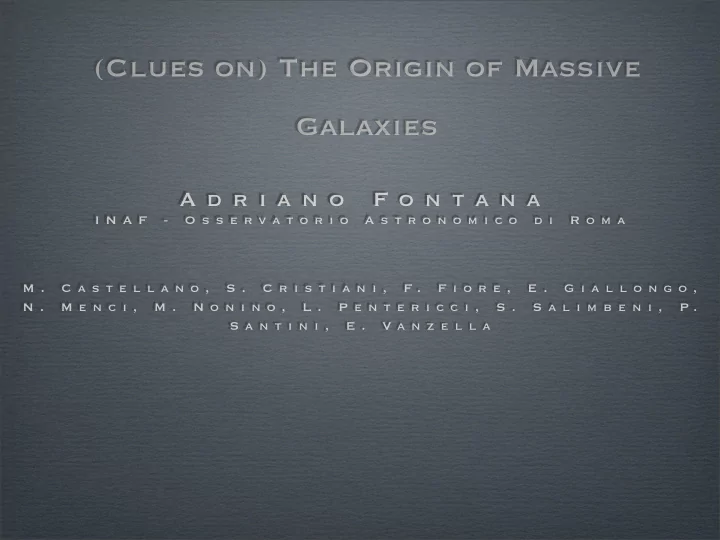

(Clues on) The Origin of Massive Galaxies A d r i a n o F o n t a n a I N A F - O s s e r v a t o r i o A s t r o n o m i c o d i R o m a M . C a s t e l l a n o , S . C r i s t i a n i , F . F i o r e , E . G i a l l o n g o , N . M e n c i , M . N o n i n o , L . P e n t e r i c c i , S . S a l i m b e n i , P . S a n t i n i , E . V a n z e l l a
GOODS-South: 4000 K<23.5 galaxies the GOODS-MUSIC sample 10000 z<6 galaxies (Grazian +06, http://lbc.oa-roma.inaf.it/goods) >1000 spectroscopic z+ well calibrated zphot Spitzer: MIPS 24µm VLT: U+JHK (UV+24µm)-to-SFR relations from HST: BVIz Papovich+07, Daddi +07 etc Spitzer:IRAC (3.5-8µm)
Pozzetti+ 07 1) Fundamental Cosmology : the density of massive galaxies as compared with the expected density of DM haloes; 2) Tests and constraints on galaxy formation models in a Λ CDM Universe : Stellar masses and SFRs are the most straightforward outputs of such models
1) Fundamental Cosmology : the density of massive galaxies as compared to the expected density of DM haloes; Fontana + 04 (see also Pozzetti +07) Rodighiero + 07
2) Tests and constraints on galaxy formation models in a Λ CDM Universe : Density of massive galaxies is 50% at z=1.5-2 Much faster evolution of massive galaxies at z>2 Fontana+ 06
Massive galaxies at high z: a test for “ab initio” theoretical models? Not a critical one (anymore)...OK within systematics What are the physical properties of the objects that contribute to the steep rise at z>2? Are they reproduced by the models?
Kitzbichler&White 07 Millennium simulation “radio mode”AGN feedback Menci+06 Menci+06 Semianalytic rendition “bright QSO phase” feedback
How to build up a homogeneous sample of red galaxies, complete in mass and redshift, discriminating between Star Forming and Passively Evolving? z ≈ 2 SED fitting Similar to many color selection criteria: E(B-V)=0.03 (I-K)/(J-K) (Pozzetti& Mannucci 00) Age = 2.5 Gyr τ = 0.1 Gyr BzK (Daddi+04) (U-V)/(V-J)(Wuyts+06) Classification of 80% of the objects is independent of the E(B-V)=0.9 details of SFRH and photo-z Age = 0.15 Gyr uncertainites τ = 1 Gyr
The contribution of Star Forming and Passively Evolving galaxies to the mass budget of the Universe Grazian +07 Passively evolving galaxies show a strong negative evolution from z~2 to z~3.
Quantitative use of the 24 micron photometry The 24mm/K flux ratio as SED indicator Empirical UV-to-MidIR SED (Polletta+06)
The 24 micron vs SED fitting The criterion based on SED fitting is in agreement with 24µm/K flux ratio. Candidate Obscured AGNs Fiore +07 ( see also Daddi+07 ) A sizeable fraction of galaxies is already in a quiescent phase at z~2. “Robust” candidates of “Red&Dead” galaxies at z>2.5
Final step: convert the observational criteria into a physical criteria --> comparison with models. SFR estimated as in Papovich+07, Daddi+07 M > 5E10 Msun Stellar Mass / SFR criterion#1 D.T. > 1E11 yr --> “Quiescent” galaxies criterion#2 D.T. < Universe Age(z) --> “Active” galaxies
Comparison of GOODS-MUSIC data with Millennium Simulation 1 “Quiescent” 0.8 0.6 0.4 0.2 0 0 1 2 3 4 1 “Active” 0.8 0.6 0.4 0.2 0 0 1 2 3 4
The Millennium Simulation seems to underpredict the “active fraction” due to an underprediction of the average SFR, while overpredicting the Mass Density Kitzbichler&White 07 Too much action moved at higher redshift and/or into smaller progenitors?
Summary & Conclusions 1) Constraints on fundamental DM statistics: passed 2) The epoch z>=2 is a major phase in the assembly of massive galaxies; - Strong evolution of the stellar mass density at z>2 (50% local) - Emergence of the red sequence from z=3.5 to z=2; 3) “Red & Dead” galaxies exist up to z=3 and most likely above: need for efficient feedback/quenching of SFR mechanisms at high z 4) At z>=2, about 50% of massive galaxies are experiencing a major peak in their SFRH: during this process they accrete a substancial fraction of their mass (see also Daddi+07) 5) The Millennium simulation seems to underpredict the “active fraction” due to an underprediction of the average SFR, while overpredicting the Mass Density: to quench SF and prevent overcooling in massive galaxies, too much action moved at higher redshift and/or smaller progenitors? Comparison with other models on the way.
Recommend
More recommend